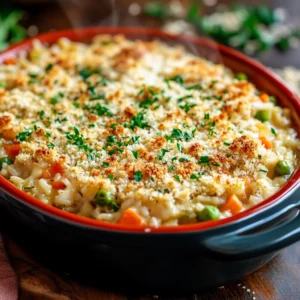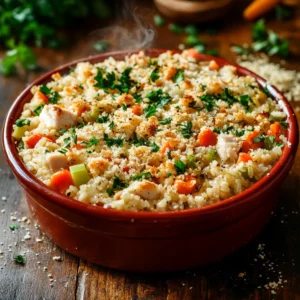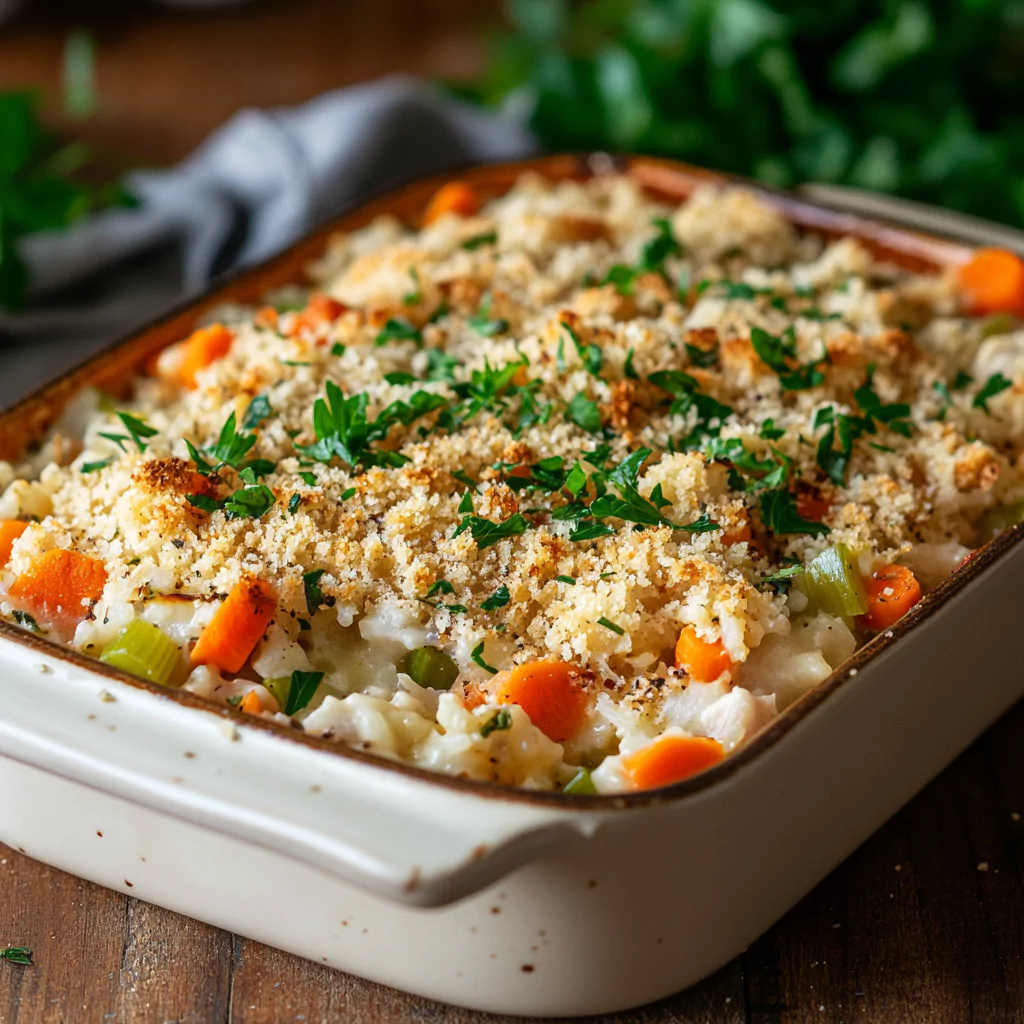Introduction: Do You Have to Cook Rice Before a Casserole?
A common question among home cooks is: Do you have to cook rice before a casserole? The answer depends on the recipe, the type of rice, and the desired outcome of your dish. This seemingly simple choice can influence everything from cooking time to flavor and texture.
Using uncooked rice saves time and adds convenience, but it requires precise liquid ratios. On the other hand, pre-cooked rice gives you better control over the final consistency of your casserole. This guide addresses these considerations to help you decide whether you should cook rice before adding it to a casserole.
Do You Have to Cook Rice Before a Casserole? Understanding the Basics
Whether or not you need to cook rice before a casserole depends on the recipe and cooking method. Let’s break down the main considerations.
Cooked Rice vs. Uncooked Rice
- Cooked Rice:
- Using pre-cooked rice ensures a consistent texture and avoids the risk of undercooked grains.
- Recipes with creamy sauces, such as the Chicken Broccoli Rice Casserole, typically require cooked rice to achieve the desired consistency.
- Uncooked Rice:
- Uncooked rice absorbs the casserole’s liquid during baking, making it an excellent option for one-pot meals.
- However, it requires careful attention to liquid ratios and baking times to prevent a soggy or crunchy result.
Why the Choice Matters
When deciding do you have to cook rice before a casserole, consider how the rice interacts with other ingredients:
- Uncooked rice absorbs liquid and flavors, but it needs enough cooking time.
- Cooked rice works better in dishes that don’t have enough liquid to cook the rice completely.
Do You Have to Cook Rice Before a Casserole? Exploring Your Options
Different recipes and scenarios dictate whether you need to cook rice beforehand.
When to Use Pre-Cooked Rice
- Time-Saving Recipes:
If you’re short on time, pre-cooked rice is the best option for speeding up meal prep. Recipes like the Million Dollar Chicken Casserole use pre-cooked rice to simplify preparation. - Delicate Ingredients:
Recipes that include quick-cooking vegetables or dairy-based sauces often call for pre-cooked rice to maintain their texture and prevent overcooking. - Leftovers:
Pre-cooked rice from a previous meal can be repurposed into a casserole, cutting down on waste and preparation time.
When to Use Uncooked Rice
- Flavor Absorption:
When wondering do you have to cook rice before a casserole, consider whether you want the rice to absorb the flavors of the casserole. Uncooked rice captures the spices and broth more effectively. - Slow-Baked Dishes:
Recipes that bake for 45 minutes or longer, such as the Crescent Roll Breakfast Casserole, often use uncooked rice for a seamless, one-pot cooking process. - Liquid-Rich Recipes:
Dishes with high liquid content, like soups and stews, can incorporate uncooked rice, which will soak up the liquid and cook evenly.
The Role of Ingredients and Time
When determining whether do you have to cook rice before a casserole, think about the ingredients:
- If your casserole contains proteins like chicken or beef, uncooked rice can cook alongside them.
- Pre-cooked rice is ideal for recipes where the other ingredients cook faster than the rice.
Types of Rice and Do You Have to Cook Rice Before a Casserole?
Different rice varieties have distinct properties, and knowing which to use is crucial when asking do you have to cook rice before a casserole.
White Rice
- Best Use: Quick recipes or creamy casseroles.
- Cooking Time: 15 minutes (pre-cooked) or 40 minutes (uncooked).
- Liquid Ratio: 2 cups of liquid per cup of uncooked rice.
- White rice is versatile and works well whether cooked or uncooked. Recipes like Watery Broccoli Casserole often use white rice for its mild flavor.
Brown Rice
- Best Use: Nutty, fiber-rich casseroles.
- Cooking Time: 30 minutes (pre-cooked) or up to 90 minutes (uncooked).
- Liquid Ratio: 2.5–3 cups of liquid per cup of uncooked rice.
- If you’re considering do you have to cook rice before a casserole, brown rice often requires pre-cooking due to its longer cooking time?
Wild Rice
- Best Use: Earthy, textured casseroles.
- Cooking Time: 45–60 minutes (pre-cooked) or 90+ minutes (uncooked).
- Liquid Ratio: 3 cups of liquid per cup of uncooked rice.
- For recipes with wild rice, pre-cooking is recommended to ensure even cooking.
Specialty Varieties
- Jasmine Rice:
- Fragrant and soft, jasmine rice works best pre-cooked to prevent mushiness.
- Basmati Rice:
- Known for its long grains and unique flavor, basmati rice should also be pre-cooked for casseroles.
Practical Tips for Perfect Rice in Casseroles
To ensure your rice casseroles turn out perfectly, follow these tips:
- Stick to Recipe Instructions:
If the recipe specifies cooked or uncooked rice, it’s important to follow the guidelines to maintain the dish’s intended flavor and texture. - Liquid Ratios Are Key:
- For uncooked rice, use 2–3 cups of liquid per cup of rice, depending on the variety.
- Pre-cooked rice requires significantly less liquid since it’s already hydrated.
- Check for Doneness:
When baking with uncooked rice, always check the casserole 10–15 minutes before the timer goes off to ensure the rice is fully cooked. - Choose the Right Dish:
For uncooked rice, use a casserole dish with a tight-fitting lid to trap steam and ensure even cooking. - Test with Leftovers:
If you’re still debating do you have to cook rice before a casserole, experiment with leftover rice in a small batch to see which method works best for you?

Liquid Ratios and Do You Have to Cook Rice Before a Casserole?
Liquid ratios are pivotal when addressing “Do you have to cook rice before a casserole?”. The correct balance ensures your rice is perfectly cooked without being too dry or mushy. The amount of liquid required depends on whether you’re using cooked or uncooked rice, as well as the type of rice itself.
Why Liquid Ratios Are Critical for Uncooked Rice
Uncooked rice absorbs a significant amount of liquid while cooking in the casserole, making precise ratios essential. A lack of liquid can result in crunchy, undercooked grains, while too much liquid may leave the casserole soggy.
Liquid Guidelines for Uncooked Rice:
- White Rice: 2–2.5 cups of liquid per cup of rice.
- Brown Rice: 2.5–3 cups of liquid per cup of rice.
- Wild Rice: 3–3.5 cups of liquid per cup of rice.
For recipes like Chicken Broccoli Rice Casserole, these ratios help the rice absorb flavorful sauces while cooking alongside the other ingredients.
Adjusting Liquids When Using Cooked Rice
Cooked rice requires less liquid since it has already absorbed water during its initial preparation. Typically, you’ll need about ½ cup of liquid per cup of cooked rice to maintain moisture and blend flavors without oversaturating the dish.
Practical Example:
If your recipe originally calls for 2 cups of uncooked rice and 5 cups of broth, switch to 4 cups of cooked rice and reduce the liquid to 1–1.5 cups.
Tips for Maintaining Balance
- Monitor Midway: Check the casserole halfway through cooking to adjust the liquid, especially when using uncooked rice.
- Use Foil: Cover your casserole with foil to retain steam, ensuring even cooking.
- Avoid Oversaturating Cooked Rice: Pre-cooked rice quickly becomes mushy if too much liquid is added.
Recipe Considerations: Do You Have to Cook Rice Before a Casserole?
Certain recipes inherently align with either cooked or uncooked rice. When deciding “Do you have to cook rice before a casserole?”, consider the recipe’s baking time, ingredients, and cooking method.
Classic Casseroles for Uncooked Rice
Many traditional casseroles are designed for uncooked rice, taking advantage of its ability to absorb flavors as it cooks. Recipes like chicken and rice casserole pair uncooked rice with slow-cooking proteins and broths.
Examples of Suitable Recipes:
- Vegetable Rice Casseroles: Broccoli, carrots, and peas blend well with uncooked rice in a creamy sauce.
- Layered Meat and Rice Bakes: Combine uncooked rice with ground beef or sausage for hearty one-pot meals.
Quick Recipes Favoring Cooked Rice
Pre-cooked rice is ideal for quick casseroles that bake for 20–30 minutes. For example:
- Cheesy Rice and Vegetable Bakes: Pre-cooked rice complements cheeses and quick-cooking veggies like zucchini.
- Leftover Rotisserie Chicken Casserole: Pair pre-cooked rice with pre-cooked chicken for a fast, flavorful meal.
Internal Tip: Recipes like Million Dollar Chicken Casserole shine when pre-cooked rice is used to minimize preparation time.
Adapting Recipes to Your Preference
If your preferred method doesn’t match the recipe:
- Converting to Uncooked Rice: Increase the liquid by 1–2 cups and extend baking time by 15–20 minutes.
- Converting to Cooked Rice: Reduce the liquid by 1–2 cups and shorten baking time by 20–30 minutes.
Do You Have to Cook Rice Before a Casserole? Key Benefits of Both Methods
When asking “Do you have to cook rice before a casserole?”, it’s important to consider the benefits of each method. Both options have advantages, depending on the recipe and your preferences.
Benefits of Using Pre-Cooked Rice
- Consistency: Pre-cooked rice guarantees even texture and eliminates the risk of undercooking.
- Time-Saving: Ideal for busy nights when quick preparation is essential.
- Perfect for Creamy Casseroles: Pre-cooked rice blends smoothly with cheese or dairy-based sauces.
Benefits of Using Uncooked Rice
- Enhanced Flavor: Cooking rice directly in the casserole allows it to absorb the dish’s spices and sauces fully.
- One-Pot Convenience: Using uncooked rice reduces prep time and dishwashing since everything cooks together.
- Cost-Effective: Dry rice is more affordable and requires no additional cooking steps.
Timing and Do You Have to Cook Rice Before a Casserole?
Timing is another essential factor when answering “Do you have to cook rice before a casserole?”. Proper synchronization ensures your casserole’s components cook evenly without overcooking or undercooking.
Synchronizing Rice with Other Ingredients
For Uncooked Rice:
- Pair with proteins that have longer cooking times, such as chicken thighs or drumsticks.
- Use vegetables like carrots or potatoes that soften at the same rate as rice.
For Pre-Cooked Rice:
- Add it during the final 15–20 minutes of baking to prevent overcooking.
- Use quick-cooking proteins like shrimp or pre-cooked meats.
Baking Times for Uncooked vs. Cooked Rice
- Uncooked Rice: Requires 45–60 minutes of baking at 350°F, ensuring it fully absorbs the liquid.
- Cooked Rice: Needs just 20–30 minutes at the same temperature to heat through and blend flavors.
Avoiding Overcooking
- Monitor Closely: Test for doneness 10–15 minutes before the recommended baking time ends.
- Add Liquid Sparingly: If the casserole looks dry, add 2–3 tablespoons of liquid to prevent scorching.
Do You Have to Cook Rice Before a Casserole? Making the Final Decision
The answer to “Do you have to cook rice before a casserole?” depends on your priorities, the recipe’s requirements, and your available time. To make the best choice, consider these factors:
When to Choose Pre-Cooked Rice
- Time-Saving: Perfect for quick meals with limited preparation time.
- Predictable Results: Guarantees consistency, especially in creamy casseroles.
- Adapts to Leftovers: Repurpose cooked rice from previous meals into new dishes.
When to Opt for Uncooked Rice
- Flavor Integration: Absorbs the dish’s spices, herbs, and sauces during cooking.
- Minimal Cleanup: Reduces the need for additional pots or pans.
- Flexible Timing: Works well in slow-baked casseroles where cooking time isn’t a constraint.

Common Mistakes: Do You Have to Cook Rice Before a Casserole?
When deciding “Do you have to cook rice before a casserole?”, common mistakes can affect the dish’s outcome. Avoiding these errors ensures a perfectly cooked casserole every time.
1. Misjudging Liquid Needs for Uncooked Rice
One of the most frequent mistakes is underestimating the liquid needed for uncooked rice. Since the rice absorbs liquid as it cooks, insufficient amounts can result in undercooked grains.
Tip:
Stick to the recommended liquid-to-rice ratios:
- White rice: 2–2.5 cups of liquid per cup of rice.
- Brown rice: 2.5–3 cups of liquid.
- Wild rice: 3–3.5 cups of liquid.
If your casserole appears dry during cooking, adding extra broth or water in small increments can prevent issues.
2. Using the Wrong Type of Rice for the Recipe
Not all rice varieties are interchangeable. For instance, long-grain rice like basmati or jasmine may work better for recipes where individual grains are desired, while short-grain rice is ideal for creamy casseroles.
Avoid: Using quick-cooking rice in recipes designed for uncooked rice. Quick-cooking rice can become mushy when overbaked.
3. Overcomplicating the Cooking Process
Another mistake is making the cooking process overly complex by adding unnecessary steps. For example:
- Pre-cooking rice when the recipe is designed for uncooked grains.
- Failing to follow the recipe’s specified baking time or temperature.
Solution:
Carefully read the recipe to understand whether pre-cooking is needed and stick to the instructions.
Practical Examples: Do You Have to Cook Rice Before a Casserole?
Examples of casseroles highlight the versatility of both cooked and uncooked rice, offering inspiration for your next dish.
Chicken and Rice Casserole (Uncooked Rice)
This timeless recipe is a favorite in countless kitchens. Uncooked rice absorbs the broth and seasonings as it bakes, creating a flavorful one-pot meal.
Ingredients:
- 1 cup of uncooked long-grain white rice.
- 2 cups of chicken broth.
- 2 chicken breasts, seasoned.
- 1 cup of cream of chicken soup.
Directions:
- Mix uncooked rice, broth, and soup in a casserole dish.
- Place seasoned chicken breasts on top.
- Cover the dish with foil and bake in a preheated oven at 350°F for approximately 45–50 minutes.
Ground Beef and Rice Bake (Cooked Rice)
Pre-cooked rice pairs beautifully with ground beef for a quick and hearty dinner.
Ingredients:
- 2 cups of cooked white rice.
- 1 lb of cooked ground beef.
- 1 cup of marinara sauce.
- 1 cup of shredded cheese.
Directions:
- Combine cooked rice, beef, and marinara in a casserole dish.
- Sprinkle cheese on top.
- Bake uncovered at 375°F for 20–25 minutes.
Vegetarian Casseroles with Versatile Rice Options
Vegetarian casseroles work well with both cooked and uncooked rice, depending on the desired texture. For instance:
- Cooked Rice Option: Combine rice with sautéed vegetables and cream sauce for a quick bake.
- Uncooked Rice Option: Layer rice with vegetable broth, tomatoes, and hearty vegetables like zucchini or eggplant.
Example Recipe: The Crescent Roll Breakfast Casserole includes versatile ingredients, allowing you to customize the rice preparation based on time.
FAQs About Do You Have to Cook Rice Before a Casserole
1. Can leftover rice be used in a casserole?
Yes, leftover rice is perfect for casseroles, especially recipes designed for pre-cooked grains. Simply mix it with other ingredients and bake to reheat.
Tip: Leftover rice tends to be dry, so add a little extra liquid or sauce to keep the casserole moist.
2. How to fix a casserole if the rice isn’t fully cooked?
If you notice that the rice is still crunchy after baking:
- Add ½ cup of warm broth or water.
- Tightly cover the dish with foil to retain steam.
- Return it to the oven and bake for an additional 10–15 minutes.
3. What happens if you accidentally cook rice when the recipe doesn’t call for it?
Pre-cooked rice in a recipe meant for uncooked rice can result in a mushy texture. To adjust:
- Reduce the liquid in the recipe by half.
- Shorten the baking time to avoid overcooking.
Conclusion: Do You Have to Cook Rice Before a Casserole?
So, do you have to cook rice before a casserole? The answer depends on factors like the recipe, type of rice, and your available time.
Key Takeaways:
- Pre-Cooked Rice: Ideal for quick, creamy casseroles where texture consistency is key.
- Uncooked Rice: Perfect for slow-baked dishes where flavor absorption and one-pot convenience are priorities.
Experimenting with both methods allows you to find what works best for your taste and schedule. Whether you prefer pre-cooked or uncooked rice, mastering liquid ratios, timing, and recipe adjustments will lead to delicious and satisfying casseroles every time.
For additional insights on perfecting casseroles, visit Bon Appetit’s Guide to Casserole Cooking.


1 thought on “Do You Have to Cook Rice Before a Casserole?”